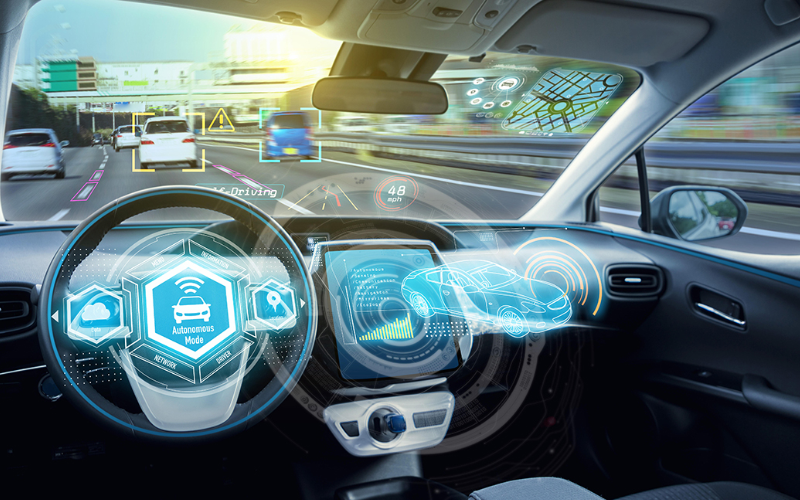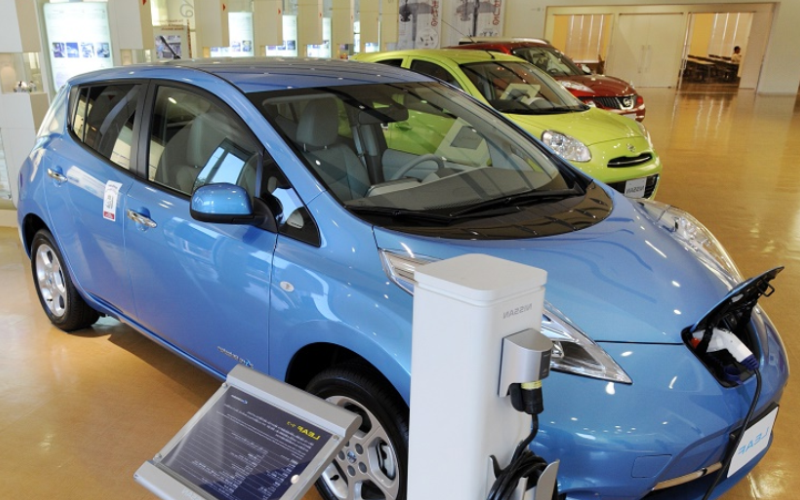Ever since at least the 1980s, anyone who visited a theater to watch the latest Hollywood blockbuster was treated to the visual fantasy of cars of the future. What features did they have? They were swimming in digital displays, interesting angular designs, and in some movies they could even fly! One other thing that really captured our imaginations, however, was the idea of the self-driving car.
Remember the 1990 film “Total Recall” with Arnold Schwarzenegger? In it, he escapes from people chasing him in a self-driving taxi called a Johnny Cab. The car was driven by a talkative robot and AI known simply as Johnny. In a somewhat more modern escape scene in the 2002 hit “Minority Report,” Tom Cruise’s character also dodges the authorities by jumping into a self-driving car into which he needn’t give any input other than a destination.
These were the self-driving cars of science fiction, but how close are we in reality to achieving something resembling this? This will be the core question of today’s blog. With so many technologies moving from science fiction to modern fact, where are our self-driving cars?
Background: SAE Levels of Automation – Defining “Self-Driving”
To start with, we need to understand how we have come to define the notion of “autonomous driving” or “self-driving.” It’s not quite as simple as you imagine. In fact, it has taken the collective minds of the Society of Automotive Engineers to put together an agreed-upon scale of automation that we now use to categorize various existing and proposed self-driving technologies.
To give you some scope, the SAE is made up of more than 128,000 engineers and related technical experts. Their expertise ranges from aerospace to automotive and commercial vehicles. These are not mere “enthusiastic amateurs,” they know of what they speak. Anyone thinking that the scale below was made up arbitrarily by some faceless committee of a handful of self-appointed experts would be wrong.
SAE Level 0 – No Automation
This is where it all began. Just about every car (though not quite) fell under what the SAE calls level 0, which simply means no level of automation at all. The SAE says this is the level in which the human “provides the dynamic driving task.” There may be some basic driver assistance systems, but none of them amount to automation and the safe operation of the car is absolutely reliant on input from a human driver.
SAE Level 1 – Driver Assistance
Level 1 includes a number of common Advanced Driver Assistance Systems that assist with some degree of acceleration and steering. For example, cruise control that can maintain a car at a certain speed or distance. At this level, however, for these systems to work as they should, and to work with any degree of safety, there still has to be a fairly high degree of human input.
SAE Level 2 – Partial Driving Automation
This is the level where most ADAS and so-called “autonomous driving systems” that are commercially available are technologically. Level 2 technology reflects the very latest ADAS systems, as well as things like Tesla’s Autopilot system. At this level, you not only get more advanced versions of level 1 assistance with speed and steering, but there is actually a capability for the vehicle to control acceleration and deceleration by itself.
Level 2 is so because even though it’s definitely a big step up from level 1 and there are more things that the vehicle can do by itself, the system (and the law) still requires that an alert and qualified human driver is sitting behind the wheel ready to take over at any moment. Their full attention is supposed to be on the road.
If you’ve ever watched cars parking themselves or moving the steering wheel while the owner works the pedals, these are also among the more advanced capabilities available at SAE level 2. Only one known system has been confirmed to have reached beyond level 2 (see more below).
SAE Level 3 – Conditional Driving Automation
As an upgrade from level 2, cars with level 3 automation are able to detect other traffic, pedestrians, cyclists and obstacles in the road, and then once detected can make an autonomous decision about what to do about it. This is known as the vehicle’s “environmental detection capability.”
Audi was running a project to make its A8L model a level 3 automated car, but Audi ran into trouble not only with the hardware and software, but also with the law in many states which would still have dubbed Audi’s A8L a level 2 because they’ve made it a legal requirement for an alert driver to always be present.
SAE Level 4 – High Driving Automation
While level 3 may still require human intervention when things go wrong, the jump to level 4 means that the vehicle can act autonomously and even intervene on itself when things go wrong. In other words, it’s able to correct its own errors without needing the input of a human to do so. It’s likely a human would need to be on “stand-by” in case something very bad went wrong, or if they wanted to simply take over, but level 4 would mean that the driver wouldn’t by default have to be paying attention.
SAE Level 5 – Full Driving Automation
Full automation means that zero human input or attention is required whatsoever. This is the kind of vehicle that you would simply get into, give a destination and then the car would do the rest. It’s likely the destination could be set by voice command. In theory, the human could be in any state in a level 5 car because no input would be needed at all. They could be fast asleep or locked in a game of chess with a fellow passenger.
The Current State of Autonomous Driving Technology
So, now we are familiar with the levels of autonomous driving technology as laid out by the SAE, let’s take a closer look at where things stand in our world today. Where is our current level of technology? What autonomous driving systems already exist? We’ll explore all of these questions in this section. The first four technologies that we are exploring are all ranked at SAE level 2.
1. Tesla Autopilot
Arguably the best-known self-driving system on the market and Tesla has touted their cars’ self-driving abilities the longest. Musk has also made some quite outlandish statements about it, saying that Tesla is incredibly close to getting fully autonomous technology, which would mean SAE level 5, even though his Autopilot remains at level 2 even with its latest “Full Self-Driving” (FSD) upgrade that it charges some $10,000 for.
Musk’s posturing aside, not to mention some of the more negative recent news regarding use of Autopilot, there is an ever-increasing body of evidence to support the fact that Autopilot is genuinely a very impressive piece of technology. Videos abound of Tesla owners demonstrating its efficacy, with Autopilot seemingly running almost entire journeys with no driver input. One point of contention though is that while Tesla gives it names like “Autopilot” and “Full Self-Driving” mode, they still have to remind their customers, “Autopilot is intended for use only with a fully attentive driver.
Somewhat more troubling are the stunts that some YouTubers have pulled to try and prove how good Autopilot is, all while ignoring the stark warning issues by Tesla. There was the infamous case of the man who drove his Tesla while putting his feet up hanging out of the window because he was so comfortable and confident in Autopilot’s capabilities (see video below).
2. Ford BlueCruise
Ford’s self-driving technology is known at BlueCruise and isn’t actually set to fully roll out until later in 2021. The plan is to first put it into the new Ford F-150 truck and the all-electric Mustang Mach-e. The system is designed to offer lane centering, navigation in heavy traffic, and a feature that can recognize if the driver’s eyes are not on the road where they should be.
Testing has been extensive in the two proposed starter models, the F-150 and electric Mustang. BlueCruise has been put through its paces over 100,000 miles of road across the US and Canada as it prepares for wider rollout later in 2021.
3. Volvo Pilot Assist
Volvo has been having a great year in sales, and they have installed their autonomous level 2 Pilot Assist system on a number of their vehicles as a standard feature. Volvo models carrying this system as standard include the S90, XC90, V90 and the V90 Cross Country. For other models not listed there, it’s still available but you have to purchase it as part of the “Advanced Package.”
What can Pilot Assist do? It helps mostly with steering, keeping the car centered in lane. It also has some autonomous control over accelerating and braking when you’re driving towards other traffic. Volvo warns that alert drivers are still necessary because their system only works in good weather and good light where it can recognize the various road markings.
Another interesting thing about Volvo is the amount of caution they are exercising when you compare them to a company like Tesla. Where Tesla’s approach has been more brazen, even calling their assist program “Autopilot,” and “Full Self-Driving,” Volvo has taken a much humbler approach, sticking with “Pilot Assist,” the “pilot” in this case being you and the system merely your helper.
Volvo has also been wary about making the switch to level 3, with the CEO Håkan Samuelsson believing that giving the vehicle too much autonomy and control is fundamentally dangerous because it takes too much responsibility away from the driver.
4. GM Super Cruise
Super Cruise is actually a fairly established technology. Many drivers of certain Cadillac models since 2017 will be familiar with it. Super Cruise can accelerate, it can do braking, and it can be used on more than 200,000 miles of highway in North America. It remains level 2, however, and requires an alert driver. It does allow the driver to take their hands off the wheel, but not their eyes off the road. Super Cruise is actually able to detect whether the driver’s eyes are looking where they should be.
5. Other Technology Companies (where OEMs are going to get the tech)
The OEMs we discussed above are developing technology, as well as pairing up with other companies to create new self-driving technology. Below we’re highlighting a few of the companies that are not car manufacturers but they are working earnestly on self-driving technology that could well be integrated into the cars of the future.
Baidu
Baidu is China’s equivalent of Google, and has paired with one of China’s largest automotive giants, Geely, to create autonomous vehicle technology. It seems they are doing quite well, too. They have been conducting testing on vehicles in select areas of the nation’s capital, Beijing. The plan is to have driverless taxi services ready for the 2022 Beijing Winter Olympics. They also want to roll out their service across the city using an app they have developed called Apollo Go.
Though there will be no driver within the vehicle, the system is not entirely without human input, perhaps being akin to a high-tech level 3 autonomous driving technology. If things go wrong or appear to be going wrong, a member of the company’s team will be able to control the car remotely and guide it safely to its destination or to pull over safely.
Argo AI
Argo AI is one of the biggest players in the field, boasting partnerships with Ford and Volkswagen. Their main breakthrough technology is what they refer to as the Argo Lidar. This system, it claims, can “overcome the limitations preventing most competitors from commercializing autonomous delivery and ride-hail services.” Their Lidar system can supposedly detect hard-to-see objects very precisely and from further away than any other system on the market (or so they claim). They also claim it has 360-degree awareness, day or night.
Argo aspires to have the technology applied not just in consumer vehicles, but also in commercial vehicles, fleet vehicles and rideshare vehicles. They believe their proprietary Lidar, which they also call “Geiger-mode” is what will give them the real edge, being able to sense the darkest non-reflective surfaces, and even instantly adapt to sudden changes in light and dark such as when you pass through a tunnel.
Waymo
Waymo is the one that most people have probably heard of before. Waymo is a subsidiary of Alphabet, which of course owns Google. Waymo started life as Google’s self-driving car project way back in 2009, and now has a life of its own. Their chief tech project now is the Waymo Driver, which they are dubbing “the world’s most experienced driver.” Their ethos is driven by a statistic that 94 percent of traffic crashes in the US are down to human error. So, logically, eliminate the human, eliminate at least some of those errors.
Waymo is arguably the most extensively tested technology, having covered some 20 billion real-world miles. Besides licensing its technology to OEMs, Waymo has also created its own vehicle services brand, Waymo One, which is already operating in Phoenix, Arizona.
https://youtu.be/b17JQrhhYgY
Case Study: Tesla Autopilot
In this section we’ll take a closer look at Tesla’s Autopilot, the technology behind it, the role of the driver and its current limitations.
Technology
Tesla’s Autopilot technology is first of all described as an “advanced driver assistance system” in its official info on Autopilot and the new Full Self-Driving Capability. It uses a Tesla model’s 8 external cameras, 12 ultrasonic sensors and the onboard computer to help guide you on your journey. It’s available on all cars built after September 2014.
The Model 3 and Model Y use a camera-based version of the system that doesn’t make use of radar. The Model S and Model X cars use radar as part of the technology. It contains many features: traffic-aware cruise control, automatic steering, automatic navigation, lane changing, parking, and even summoning the car from a tight parking spot so you can then get in, and many more.
Driver Input
Tesla makes it very clear that Autopilot and the FSD upgrade together is a “hands-on driver assistance system that is intended to be used only with a fully attentive driver.” The driver has to start driving the car and get it moving before activating the Autopilot system. After activating, they can deactivate and reassume control simply by steering, braking, or deactivating the system at the control stalk by the steering wheel.
Tesla has received criticism from authorities and other drivers who are often claiming that they spot Tesla drivers asleep at the wheel, playing games with the front passenger, or otherwise not paying attention to the road ahead. Some videos have prompted fierce opposition to the technology. The company believes, however, that their own warnings are cover enough for when things go wrong.
Limitations
The naming of their software and bluster of their customers and even the founder, Elon Musk when it comes to Tesla and Autopilot have led to problems for them. This is best shown by the words of their associate general counsel, Eric C. Williams. He said, talking about Autopilot and Full Self-Driving mode,
“Currently neither Autopilot nor FSD capability is an autonomous system, and currently no comprising feature, whether singularly or collectively, is autonomous or makes our vehicles autonomous.”
It doesn’t get much clearer than that. Even with the upgrade to “Full Self-Driving” the technology remains at SAE level 2, and didn’t take it up to level 3 as many fans and others had anticipated and hoped that it would. In fact, only one company has achieved Level 3 as of yet (see further below).
Other limitations on Autopilot are listed in Tesla’s official information and should be taken as a serious warning by Tesla owners and anyone who thinks that their Tesla is a fully autonomous self-driving car.
- Heavy rain, snow, fog and other weather that creates limited light/visibility
- Bright light from sun glare, oncoming full beam, etc.
- Bad road conditions that obscure markings like snow and mud
- Obstruction by paint, car accessories, adhesive stickers and more
So unless you live in a consistently sunny, non-dusty environment where AQI is always below 50, there’s likely to be many days where you can’t actually use the system anyway.
Scenario: Could It Drive You Home Drunk?
No, it definitely could not. The main obstacle here is that first, Autopilot is only an SAE level 2 system, which means that it requires a competent and aware driver to operate the vehicle at all times. If you were drunk, you wouldn’t be able to safely start up and move the car off in order to get Autopilot active.
In any event, Tesla makes it clear that the driver is responsible for the vehicle while it is in Autopilot mode. That being the case, being drunk in it is not an option. Those people hoping for a self-driving car to be the designated driver at a party or night out will have to wait for level 5 technology to arrive.
Next Steps; Getting to Level 3
So when will we realistically get to the next level? We appear to be in something of a level 2 rut at the moment. Might we be able to get out of it soon? Japanese auto giant Honda has actually already made it there, making it the first company to achieve a viable SAE level 3 self-driving technology. It was announced in March 2021, and they call the system Traffic Jam Pilot.
The somewhat bad news is that while it’s here and while it does work, it’s only applied to a very limited number of Honda Legend models – only 100 to be exact — and is still really in its trial form. The models fitted with the Traffic Jam Pilot system were made available for leasing. The system handles brakes, steering and throttle, as well as maintaining a safe following distance, speed and lane position with no driver input.
Conclusion: The Road to SAE Level 5
Ultimately, then, our goal is to get to a point where we have a technology that would be dubbed SAE Level 5. Only then would we have vehicles that resemble our much-loved cars of science fiction. Other questions remain, however, especially when you consider the amount of opposition that exists to the very notion of self-driving cars.
There are always some who struggle to accept the adoption of certain modern technology. Don’t forget that even electricity had its detractors back in the early days, with many shunning it for fear of the “vapors” that came out of the plug sockets. If there were no future to self-driving cars, then the many companies we have referenced further above in today’s blog piece would not even bother embarking on this long and difficult journey of development.
There are many more milestones to reach as we attempt to mainstream level 3 and then move to the next rungs on the ladder. In the end, though, can we deny the inevitability of self-driving technology? It’s one of those things — like visiting the moon or Mars — that once humans set their mind to, they’re likely to get there in the end, come Hell or high water. Watch this space, because the self-driving car sector is here to stay.



